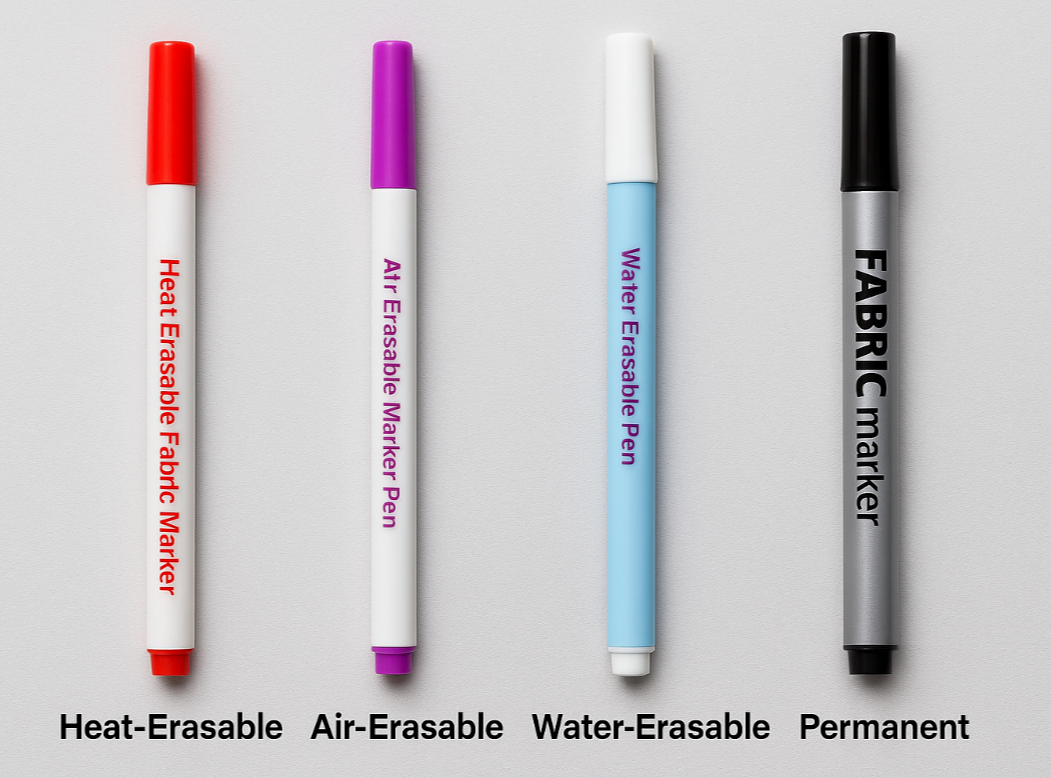
Fabric Marker Uses, Tricks & Safety: The Invisible Hero Behind Perfect Stitches
Ever wondered how your tailor’s chalk lines vanish just in time? That’s no trick—it’s chemistry. Specifically, the kind built into a fabric marker.
Unlike your average pen, a fabric marker is engineered for one thing: temporary precision. It helps you mark, map, and cut with confidence—then disappears when it’s no longer needed.
Whether you’re a beginner or a seasoned sewist, knowing which marker to use can make or break your project.
What Is a Fabric Marker and How Is It Different?
At a glance, fabric markers might look like ordinary highlighters or pens. But their ink tells a different story. While office pens are made to stay, fabric markers are made to go away—cleanly and on command.
Most temporary fabric markers use thermochromic ink made with leuco dyes—pigments that become invisible when exposed to heat (usually from an iron). Others react to air or water. This ability to disappear makes them a staple in every sewing kit.
Types of Fabric Markers (And Which One You Need)
In North America, fabric markers typically fall into four types. Each has a use-case depending on your fabric type and workflow:
1. Heat-Erasable Fabric Markers
- How it works: Ink disappears with heat (usually ironing).
- Best for: Cotton, linen, denim, and other heat-safe fabrics.
- Caution: Not suitable for synthetics like nylon or spandex, which can melt or distort under high heat.
2. Air-Erasable Fabric Markers
- How it works: Marks vanish on their own within 12–72 hours.
- Best for: Projects that don’t involve pressing or are on delicate, heat-sensitive fabric.
- Tip: Humidity speeds up the fading, so time your sewing accordingly.
3. Water-Erasable Fabric Markers
- How it works: Marks disappear with a light water spray.
- Best for: Embroidery, quilting, and light-colored fabrics.
- Caution: Don’t iron before rinsing—heat may set the mark permanently.
4. Permanent Fabric Markers
- How it works: Ink stays for good—used for decorating rather than construction.
- Best for: T-shirt art, name labeling, or any project that calls for staying power.
Now that we’ve covered the four most common types of fabric markers, let’s take a closer look at the one that’s become a staple in most apparel studios and home sewing kits: the heat-erasable fabric marker.

It's the go-to tool for tailors, designers, and hobbyists alike—thanks to its clean finish, real-time editability, and compatibility with iron-safe fabrics. In the world of garment making, it’s not just helpful—it’s essential.
What Makes a Heat-Erasable Fabric Marker Different?
Your office pen’s ink is designed to last forever. A fabric marker, on the other hand, is built to disappear.
Most of them contain thermochromic ink, which fades or becomes invisible when exposed to heat (typically around 60–70°C).
The key ingredient? A combination of leuco dyes and weak acids that react to temperature shifts.
So yes, when your iron glides over your carefully marked pattern and the lines melt away—it’s chemistry doing its thing.
Are Fabric Markers Easy to Find?
Absolutely. They're sold in most craft stores, online retailers, and even some big box stores. The keyword is "heat erasable" or "air erasable"—each has its own niche depending on your sewing timeline and fabric type.
How They're Used in Fashion & Sewing
In the garment industry, fabric markers are essential for:
- Marking dart positions
- Drawing cut lines
- Mapping embroidery
- Labeling fabric rolls (without permanent damage)
They are the quiet MVPs in fashion workshops from Paris to Guangzhou. Paired with sewing clips—which hold fabric without pin holes—they create a damage-free, high-precision workflow.
What If the Fabric Can’t Take the Heat?
Here’s the plot twist: not all fabrics play nice with heat. Some materials—like nylon, acetate, acrylic, spandex blends, or coated synthetics—can warp, melt, or lose texture when exposed to a hot iron.
That means your heat-erasable fabric marker might leave a ghost behind, or worse, permanently set.
So what do pros do?
- Use air-erasable markers: These vanish on their own after 12–72 hours, depending on humidity. Great for delicate or high-performance fabrics.
- Test before marking: Always trial on a fabric scrap first. Some synthetic finishes, especially water-repellent ones, can “lock in” certain inks.
- Use UV-erasable ink: A newer innovation that disappears under sunlight. Ideal for activewear and heat-sensitive textiles.
The key is to treat fabric marking as part of your fabric selection strategy. Know your fiber content, and your sewing tools will serve you—not sabotage you.
Everyday Uses You Probably Never Considered
Here’s where it gets fun.
- Tattoo placement trials: Test a temporary tattoo location before you commit.
- Kids’ clothing games: Let your child draw on a shirt that disappears in the laundry.
- Secret messages: Write love notes that disappear after ironing.
It’s not just for tailors. The creative potential is endless.
How to Build a Beginner Sewing Kit That Actually Works
A real toolkit isn’t stuffed with fancy gadgets. It has what works:
- Fabric marker (thermal or air-erasable)
- Sewing clips (they don’t snag like pins)
- A solid set of sewing tools—like measuring tape, rotary cutter, and curved rulers.
Start with these, and you'll sew smarter—not harder.
Want to learn more tricks like this? Check out our Sewing & How-To Guides for simple, smart, and sometimes surprising insights on building better clothes at home.
